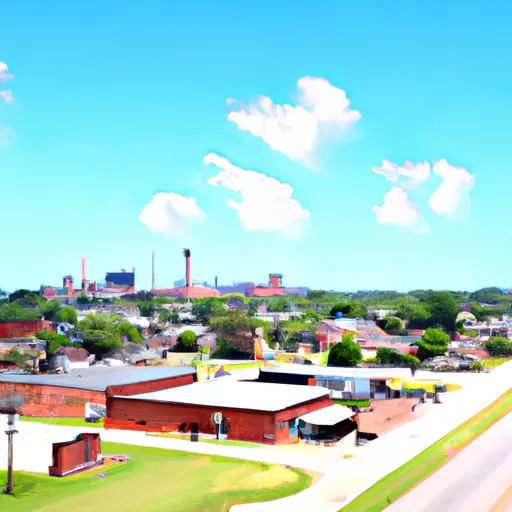-
 Snoflo Premium
Snoflo Premium
Get unlimited access to all our content
With no Ad interruptions! - Start Your Free Trial Login with existing account
Vidor
Eden Index
Climate
7.2
•
Recreation
3.4
•
Community
2.6
•
Safeguard
4.7/10

Vidor, Texas is a small city located in Orange County, approximately 90 miles northeast of Houston. The climate in Vidor is classified as humid subtropical, characterized by hot, humid summers and mild winters. Summers are typically hot and can be quite humid, with temperatures averaging in the mid to high 90s Fahrenheit. Winters are mild, with temperatures ranging from the 40s to 60s Fahrenheit.
Vidor is surrounded by various bodies of water, including the Sabine River and Cow Bayou. These water sources contribute to the hydrology constituents of the area, supporting diverse flora and fauna. The Sabine River provides opportunities for fishing, boating, and other water-based activities. Cow Bayou, on the other hand, offers scenic views and opportunities for bird watching and wildlife observation.
Outdoor recreation in Vidor is abundant, with several parks and nature reserves in the area. Claiborne West Park and Vidor City Park are popular destinations for picnicking, walking trails, and sports activities. Additionally, nearby Big Thicket National Preserve and Piney Woods Nature Preserve offer opportunities for hiking, camping, and exploring the region's unique ecosystems. Vidor provides a range of recreational activities suitable for nature enthusiasts and outdoor adventurers.
What is the Eden Index?
The Snoflo Eden Index serves as a comprehensive rating system for regions, evaluating their desirability through a holistic assessment of climate health, outdoor recreation opportunities, and natural disaster risk, acknowledging the profound impact of these factors on livability and well-being.
Climate Health Indicator (CHI): 7.2
Vidor receives approximately
1488mm of rain per year,
with humidity levels near 90%
and air temperatures averaging around
20°C.
Vidor has a plant hardyness factor of
9, meaning
plants and agriculture in this region tend to thrive here all year round.
By considering the ideal temperature range, reliable water supplies, clean air, and stable seasonal rain or snowpacks, the Climate Health Indicator (CHI) underscores the significance of a healthy climate as the foundation for quality living.
A healthy climate is paramount for ensuring a high quality of life and livability in a region, fostering both physical well-being and environmental harmony. This can be characterized by ideal temperatures, reliable access to water supplies, clean air, and consistent seasonal rain or snowpacks.
Weather Forecast
Streamflow Conditions
Neches
Area Rivers
Neches
Snowpack Depths
Neches
Reservoir Storage Capacity
Neches
Groundwater Levels
Recreational Opportunity Index (ROI): 3.4
The Recreational Opportunity Index (ROI) recognizes the value of outdoor recreational options, such as parks, hiking trails, camping sites, and fishing spots, while acknowledging that climate plays a pivotal role in ensuring the comfort and consistency of these experiences.
Access to outdoor recreational opportunities, encompassing activities such as parks, hiking, camping, and fishing, is crucial for overall well-being, and the climate plays a pivotal role in enabling and enhancing these experiences, ensuring that individuals can engage in nature-based activities comfortably and consistently.
Camping Areas
| Campground | Campsites | Reservations | Toilets | Showers | Elevation |
|---|---|---|---|---|---|
| Martin Dies State Park | 225 | 88 ft | |||
| Rayburn - Sam Rayburn Reservoir | 70 | 183 ft | |||
| Campers Cove - Town Bluff Reservoir | None | 93 ft | |||
| Claiborne West Park | None | 16 ft | |||
| Mill Creek - Sam Rayburn Reservoir | 110 | 181 ft | |||
| Village Creek State Park | 41 | 36 ft | |||
| Sandy Creek - Town Bluff Reservoir | 70 | 112 ft | |||
| Twin Dikes - Sam Rayburn Reservior | 45 | 198 ft | |||
| Sandy Creek | 15 | 161 ft | |||
| Ebenezer - Sam Rayburn Reservoir | 30 | 192 ft |
Nearby Ski Areas
Catastrophe Safeguard Index (CSI):
The Catastrophe Safeguard Index (CSI) recognizes that natural disaster risk, encompassing floods, fires, hurricanes, and tornadoes, can drastically affect safety and the overall appeal of an area.
The level of natural disaster risk in a region significantly affects safety and the overall livability, with climate change amplifying these risks by potentially increasing the frequency and intensity of events like floods, fires, hurricanes, and tornadoes, thereby posing substantial challenges to community resilience and well-being.
Community Resilience Indicator (CRI): 2.6
The Community Resilience Indicator (CRI) recognizes that education, healthcare, and socioeconomics are crucial to the well-being of a region. The CRI acknowledges the profound impact of these elements on residents' overall quality of life. By evaluating educational resources, healthcare accessibility, and economic inclusivity, the index captures the essential aspects that contribute to a thriving community, fostering resident satisfaction, equity, and social cohesion.

